#elephantinae
Text
Ernst Haeckel was born #OTD (16 Feb 1834 - 9 Aug 1919). Here are two of his Kunstformen der Natur (1904) reptile plates that don't get shared as often, along with keys to the species depicted: Plate 79 Lacertilia (lizards) + Plate 89 Chelonia (turtles).




Key to Plate 79:
1. Cameroon Sailfin Chameleon
2. Chameleon Forest Dragon
3. Flying Dragon
4. Texas Horned Lizard
5. Kuhl's Flying Gecko
6. Common Basilisk
7. Frill-necked Lizard
8. Thorny Devil
-
1.Chamaeleon montium (Buchholz) = Trioceros montium/Chamaeleo montium Buchholz, 1874 (See Trioceros montium)
2. Lophyrus tigrinus (Duméril) = Gonocephalus chamaeleontinus Laurenti, 1768 (See Gonocephalus chamaeleontinus)
3. Draconellus volans (Linné) = Draco volans Linnaeus, 1758 (See Draco volans)
4. Phrynosoma cornutum (Wiegmann) = Phrynosoma cornutum (Harlan, 1825) (See Phrynosoma cornutum)
5. Ptychozoon homalocephalum (Kuhl) = Ptychozoon kuhli Stejneger, 1902 (See Ptychozoon kuhli)
6. Basiliscus americanus (Daudin) = Basiliscus basiliscus (Linnaeus, 1758) (See Basiliscus basiliscus)
7. Chlamydosaurus kingii (Gray) = Chlamydosaurus kingii Gray, 1827 (See Chlamydosaurus kingii)
8. Moloch horridus (Gray) = Moloch horridus Gray, 1841 (See Moloch horridus)
Key to Plate 89:
1: Leatherback Turtle
2: Hawksbill Turtle
3: Argentine Snake-necked Turtle
4: Mata Mata
5: Geometric Tortoise
6: Galápagos Tortoise
7: Common Snapping Turtle
-
1. Dermatochelys coriacea (Blainville) = Dermochelys coriacea (Vandelli, 1761)
2. Caretta imbricata (Gray) = Eretmochelys imbricata (Linnaeus, 1766)
3. Hydromeda tectifera (Wagler) = Hydromedusa tectifera Cope, 1869
4. Chelys fimbriata (Duméril) = Geochelone nigra (Quoy & Gaimard, 1824)
5. Testudo geometrica (Linné) = Psammobates geometricus (Linnaeus, 1758)
6. Testudo elephantina (Duméril) = Dipsochelys dussumieri Gray, 1831
7. Chelydra serpentina (Schweigger) = Chelydra serpentina (Linnaeus, 1758)
#turtle#turtles#tortoise#tortoises#lizard#lizards#reptiles#Chelonia#Testudines#Lacertilia#herpetology#natural history art#scientific illusration#Ernst Haeckel#European art#20th century art#1900s#Art Nouveau#illustration#print#book plate#Kunstformen der Natur#OTD#animals in art
6 notes
·
View notes
Text





All Elephants
Elephant
Asian Elephant
Mammoth
Elephantastic
Elephantina
0 notes
Text
Elephant – The giant creature of the present time on Earth
The elephant is the largest land animal. Three living species are presently recognized the African backcountry giant, the African timber giant, and the Asian giant. They’re an informal grouping within the subfamily Elephantinae of the order Proboscidea; defunct-elephant proboscideans include the monsters, gomphotheres, and Stegodon.
Elephantine also contains several defunct groups, including the monsters and Palaeoloxodon. African elephants have larger cognizance and hollow tails, whereas Asian elephants have lower cognizance, and convex or position tails. The distinctive features of all elephants include a long conk called a box, tusks, large observance flaps, massive legs, and tough but sensitive skin.
The box is used for breathing, bringing food and water to the mouth, and grasping objects. Tusks, which are deducted from the incisor teeth, serve both as munitions and as tools for moving objects and digging. The large observance flaps help in maintaining a constant body temperature as well as in communication. The pillar- suchlike legs carry their great weight.
Elephants are scattered throughout sub-Saharan Africa, South Asia, and Southeast Asia and are set up in different territories, including leas, timbers, comeuppance, and morasses. They’re carnivorous, and they stay near water when it’s accessible. They’re considered to be cornerstone species, due to their impact on their surroundings. Elephants have a fission–emulsion society, in which multiple family groups come together to socialize.
Ladies( cows) tend to live in family groups, which can correspond to one womanish with her pins or several affiliated ladies with seeds. The groups, which don’t include bulls, are generally led by the oldest cow, known as the dame.
male (bull)
Males( bulls) leave their family groups when they reach puberty and may live alone or with other males. Adult bulls substantially interact with family groups when looking for a mate. They enter a state of increased testosterone and aggression known as a condition, which helps them gain dominance over other males as well as reproductive success. Pins are the center of attention in their family groups and calculate their matters for as long as three times.
Elephants can live up to 70 times in the wild. They communicate by touch, sight, smell, and sound; elephants use infrasound and seismic communication over long distances. Elephant intelligence has been compared with that of primates and cetaceans. They appear to have tone-mindfulness and appear to show empathy for dying and dead family members.
About

Elephant tusks serve numerous purposes. These extended teeth can be used to cover the giant’s box, lift and move objects, gather food, and strip dinghy from trees. They can also be used for defense. During times of failure, mammoths indeed use their tusks to dig holes to find water resistance.
African Breed
Two genetically different African species live the champaign giant and the timber giant, with a number of characteristics that separate them both. The African champaign giant is the largest giant species, while the Asian timber giant and the African timber giant are of a similar, lower size.
Asian mammoths differ in several ways from their African cousins, with further than 10 distinct physical differences between them. For illustration, Asian mammoths’ cognizance is lower compared to the large addict-shaped cognizance of the African species. Only some manly Asian mammoths have tusks, while both manly and womanish African mammoths grow tusks.
Led by a dame, mammoths are organized into complex social structures of ladies and pins, while manly mammoths tend to live in insulation or in small bachelorette groups. A single shin is born to a womanish formerly every four to five times and after a gravidity period of 22 months – the longest of any mammal. Pins are watched for by the entire herd of affiliated ladies. womanish pins may stay with their motherly herd for the rest of their lives, while males leave the herd as they reach puberty.
0 notes
Photo

African bush elephant (Loxodonta africana)
Photo by Johan Swanepoel
#african bush elephant#african elephant#elephant#loxodonta africana#loxodonta#elephantinae#elephantidae#elephantoidea#elephantimorpha#elephantiformes#proboscidea#tethytheria#paenungulata#afrotheria#atlantogenata#eutheria#mammalia#tetrapoda#vertebrata#chordata#juvenile
2 notes
·
View notes
Photo

Elephant on a rocky island in Kafue River by cirdantravels (Fons Buts) this rather young bull elephant had crossed to an island in the middle of the Kafue River to feed on some bushes. He is looking at us while we are drifting closer loxodonta africana Afrikaanse olifant Eléphant d'Afrique Afrikanischer Elefant Many thanks for your views, favorites and supportive comments. All rights reserved. ButsFons©2017 Please do not use my photos on websites, blogs or in any other media without my explicit permission. http://ift.tt/2AziFJ6
1 note
·
View note
Text
Mammuthus

South African Mammoth by Scott Reid
Etymology: Earth-Horn
First Described By: Brookes, 1828
Classification: Biota, Archaea, Proteoarchaeota, Asgardarchaeota, Eukaryota, Neokaryota, Scotokaryota Opimoda, Podiata, Amorphea, Obazoa, Opisthokonta, Holozoa, Filozoa, Choanozoa, Animalia, Eumetazoa, Parahoxozoa, Bilateria, Nephrozoa, Deuterostomia, Chordata, Olfactores, Vertebrata, Craniata, Gnathostomata, Eugnathostomata, Osteichthyes, Sarcopterygii, Rhipidistia, Tetrapodomorpha, Eotetrapodiformes, Elpistostegalia, Stegocephalia, Tetrapoda, Reptiliomorpha, Amniota, Synapsida, Eupelycosauria, Sphenacodontia, Sphenacodontoidea, Therapsida, Eutherapsida, Neotherapsida, Theriodontia, Eutheriodontia, Cynodontia, Epicynodontia, Eucynodontia, Probainognathia, Chiniquodontoidea, Prozostrodontia, Mammaliaformes, Mammalia, Theriiformes, Holotheria, Trechnotheria, Cladotheria, Zatheria, Tribosphenida, Theria, Eutheria, Placentalia, Atlantogenata, Afrotheria, Paenungulata, Tethytheria, Proboscidea, Elephantiformes, Elephantimorpha, Elephantida, Elephantoidea, Elephantidae, Elephantinae, Elephantini, Elephantina
Referred Species: M. africanavus (African Mammoth), M. columbi (Columbian Mammoth), M. creticus (Cretan Dwarf Mammoth), M. exilis (Pygmy Mammoth), M. lamarmorai (Sardinian Pygmy Mammoth), M. meridionalis (Southern Mammoth), M. primigenius (Woolly Mammoth), M. rumanus (Romanian Mammoth), M. subplanifrons (South African Mammoth), M. trogontherii (Steppe Mammoth)
Status: Extinct
Time and Place: Mammoths have been around from 5 million years ago, until 3,700 years ago (give or take a few hundred years)


Mammoths are known from throughout North America and Afroeurasia
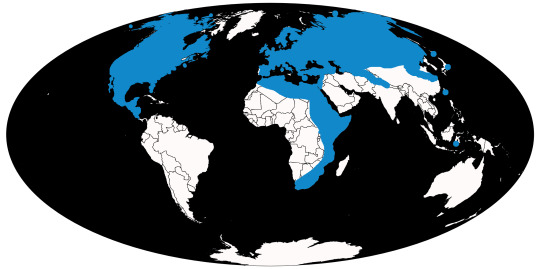
Physical Description: Mammoths were (mostly) large, elephanty creatures - with big bodies, long limbs, trunks, small tails, and tusks coming out of their mouths in both sexes. Most were about as large as Asian elephants, though some may have exceeded 12 tonnes. Still, there were dwarf species as well, which were quite small - some not even breaking 1000 kilograms. They grew their first tusks at the age of six months, which were then replaced at eighteen months by the permanent set. These would then grow at about 2.5 to 15.2 centimeters per year. Their teeth were distinctive - with rows of ridges that looked almost like the body of an arthropod (rather than the more flat surface seen in contemporary mastodons).

By FunkMonk, in the Public Domain
The mammoths had small ears, primarily due to the need to conserve body heat in most cases, unlike modern elephants which have larger ears with which to let off excess body heat. They had wide feet, splayed apart to help hold up their bodies. The males usually would grow larger than the females, based on the shape of the pelvis in fossils and frozen remains of these mammals. And, though a few species are very hairy - leading to the famed Woolly Mammoth - not all of them were, and many species of this genus were naked, with grey or more beige colored skin, as they lived in drier and warmer environments and needed to let off heat and sweat. Those that were hairy had thick layers of fur covering their entire bodies, even shorter tails to reduce frostbite, and thick layers of fat for keeping warm. A few species - notably, the Woolly Mammoth - had very brown, fluffy fur. Finally Mammoths, like modern elephants, were extremely intelligent animals, and had the brain and head size to match.

Woolly Mammoth by Mauricio Antón, CC BY 2.5
Diet: Mammoth diet varied from species to species and location to location of mammoths, though they were, overall, herbivores. Some mainly grazed on things like cacti leaves, trees, and shrubs; others, herbs, grasses, and shrubs; still more, forbs, rather than grass. Sometimes, babies that were no longer drinking milk would eat the poop of adults, like modern elephants, as they could not chew properly on plant material yet. This would also lead to feeding on fungi associated with poop, in addition to the plant material present.
Behavior: Mammoths were, in general, herding animals, much like modern elephants - in fact, it is theorized that they probably had social structures very similar to their living relatives. They had females living in herds, headed by a matriarch, that was the source of wisdom for the whole heard; meanwhile, the males would live alone or form loose groups of convenience when the situation arose. These herds would, oftentimes, migrate from region to region based on weather patterns and seasonal change. They could form herds of thousands of individuals of a variety of ages, with the adorable image of juveniles and young running to keep up with the strides of the much larger adults.
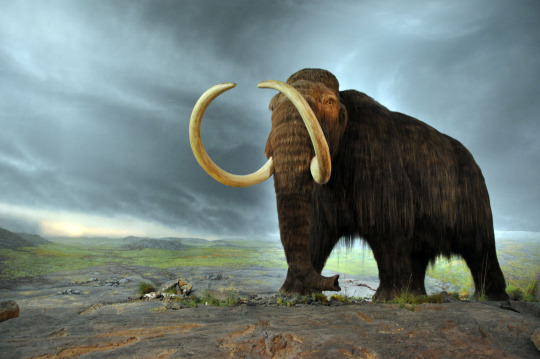
Woolly Mammoth by Flying Puffin, CC BY-SA 2.0
Mammoths, like modern elephants, mainly interacted with their environments with their trunks, which were essentially fifth limbs for these animals. They grabbed objects in their environments and talked to each other through the movement of their trunks. The trunks were also used for grabbing food in a lot of situations, pulling up coarse tundra grass and other food items and brought to the mouth, where it would then be chewed with the trough, specialized teeth. They used their tusks for defense from predators, though this wasn’t very helpful for the juveniles, who did not have extensive tusks. The mammoths also fought each other with their tusks, especially males, who would interlock the tusks and even break them while fighting for mates. They could also use the tusks to strip off bark and gather up food, even by digging in the dirt for food.
Ecosystem: Mammoths lived in a wide variety of habitats overall, though of course these differed from species to species. They lived across savanna and desert, steppe and tundra, grassland and scrubland, and even in sparse forest and higher elevations. As for predators, Mammoths were heavily at risk from predators such as lions, sabre-toothed cats, various types of wolves and other dogs, and of course, humans - which are probably the reason Mammoths are extinct today.

Cave Art from PalaeoAmerica, in the Public Domain, depicting two Columbian Mammoths (with a bison drawn over the right one)

Kapova Cave, in the Public Domain
Other: How did Mammoths go extinct? Apart from earlier species, the answer seems to be a combination of climate change and human activity. Multiple species - especially the Columbian and Woolly Mammoths - are known to have been hunted by humans, and cave drawings depict this activity for both of these species. This combination had a terrible effect on all species of mammoths - rising sea levels, with wildfires, and human hunting lead to the extinction of the Pygmy Mammoth, despite not being as large and specialized as those more iconic, giant species of mammoths elsewhere. Habitat shrinkage did not help with Mammoth populations; but human activity definitely contributed, as many populations of mammoth were heavily impacted by human activity. Prior to this, there was extensive genomic meltdown, as DNA diversity went into heavy decline for the past few thousand years. Isolated populations of mammoths - such as those on islands - showed the most extreme decline as the climate changed and humans became more common. The final death knell came from population fragmentation - with mammoths no longer having overlapping ranges, isolated populations were more susceptible to these rapid changes, and each subsequently went extinct due to climate change and human activity (with different causes being more or less important depending on the population in question).

Steppe Mammoth by Titus 322, in the Public Domain
Species Differences: There are 10 species of mammoth, each very distinct from the others, and each occupying unique environments and locations. Some are older than the others, as well.
The oldest species, M. subplanifrons, or the South African Mammoth, appeared about 5 million years ago - at the very beginning of the Pliocene. It spread from South Africa to the East African region, where it became most common in Ethiopia (funnily enough, the same time and location as human evolution, really). They were very similar to later mammoths, having spirally twisting tusks and large size - weighing up to 9 tonnes. They went extinct within the Early Pliocene and, given that they lived in Africa, were probably not very hairy as far as mammoths go; living mainly on savannas and other habitats that we see modern African Elephants on today.

African Mammoth by Apokryltaros, CC BY 2.5
The second oldest species, M. africanavus, the African Mammoths, lived from the Late Pliocene (about 3 million years ago) through the earliest part of the Pleistocene, about 1.65 million years ago. These two early species in Africa point to an African origin for the Mammoths. It has been found in Chad, Libya, Morocco, and Tunisia - showing the northern migration of Mammoths in their early evolution. They had very widely diverging tusks, much more so than other mammoths.
The next in the group, M. rumanus, the Romanian Mammoth, is one of our earliest examples of a Mammoth that spread to Europe - having been found in the late Pliocene of the UK and Romania. Being a very short lived and poorly known species, it is difficult to know much about it, though it does point to Mammoths migrating out of Africa through the Levant region, up to Eurasia from there. It’s possible that the Romanian Mammoth helps to show more about the dispersal of this genus through Eurasia as the Ice Age began in the Pleistocene.
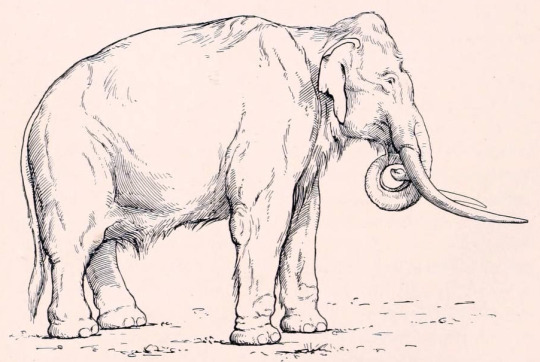
Southern Mammoth by Erwin S. Christman, in the Public DOmain
The Southern Mammoth, M. meridionalis, lived from the end of the Pliocene through the beginnings of the Pleistocene, and is known from Europe through Central Asia. It is known from many remains, which pinpoint that it may have been very closely related to the African Mammoth, though currently it is hypothesized that the South African Mammoth was the ancestor of all other forms. The Southern Mammoth grew to be about 4 meters tall and weighed 10 tonnes, making it one of the largest of the group. It had very robust, twisted tusks like other mammoths. It lived, generally, during a more mild time of the Ice Age, feeding mainly on deciduous trees and living in grassy, open habitats with small groves here and there. It was a browser, feeding mainly on higher level foliage.
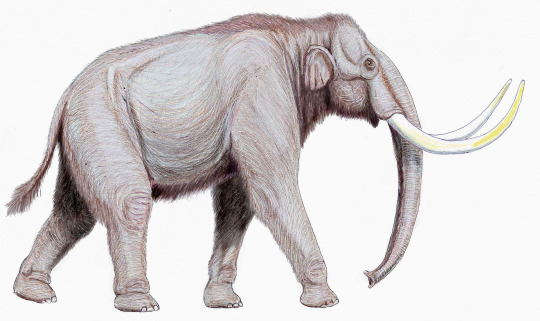
Steppe Mammoth by Dmitry Bogdanov, CC BY 3.0
All other Mammoths lived from the Pleistocene on, with some making it into the Holocene (and subsequently going extinct during the Pleistocene-Holocene Megafaunal Extinctions). The Steppe Mammoth is the next in our temporal sequence, M. trogontherii, known from Siberia in the middle of the Pleistocene - the first stage in the evolution of steppe and tundra mammoths during the glacial periods of the time. It probably had fur on most of its body - shorter than that of the Woolly Mammoth, but not by much. It had a short skull and small jaw compared to other mammoths, and the males had tusks with tips that could grow extra long and curved. They grew up to 4 meters tall and around 10 tonnes in weight. It is known mainly from fossilized teeth, with skeletons being rare, though some complete skeletons have been excavated in northern parts of the UK and siberia. It probably ate mainly shrub plants and tundra forbs.

Columbian Mammoth by Dmitry Bogdanov, CC BY-SA 4.0
The next species of Mammoth to evolve was the famed Columbian Mammoth, of the mid Pleistocene through Early Holocene of North America. Though it’s range was next to that of the Woolly Mammoth, they clearly divided North America between the two, with Woolly taking the northern half of the continent, and the Columbian mammoth taking the southern half. The Columbian Mammoth is known from a lot of fossils, across a variety of localities, and show the initial spread into North America by mammoths in an earlier in-between period of the Ice Age than the expansion of Woolly Mammoths later. It evolved from the Steppe Mammoth, which migrated across the Bering Strait into North America, down corridors available between glaciers through to the bulk of the area that would be the continental United States. The Columbian Mammoth grew to 4 meters in height and 10 tonnes in weight, making it larger than the Woolly Mammoth and the African Elephant. It also had fairly primitive teeth compared to other mammoths. It had tusks directed farther apart than those of other mammoths, and it had a longer tail. Since it lived in warmer habitats, it lacked a lot of the adaptations for the cold, and probably didn’t have much in the way of hair for keeping warm. Its tusks were excessively long, especially compared to modern elephants.
Many Columbian Mammoths are found in Elephant Graveyard fossil deposits, indicating areas where the bones of individuals would accumulate due to the movement of water. Additionally, many fossil remains are found in tar pit accumulations, in addition to sinkholes and other natural traps. Most fossils found in these sites are actually males, which were more likely to put themselves in danger than the females - lured to these holes by warm water and vegetation at the edges. These elephants would have needed to spend most of their day foraging, using their trunks to pull up grass, flowers, and other types of food. It’s possible that these mammoths could have reached even 80 years in age, growing for most of their lives.
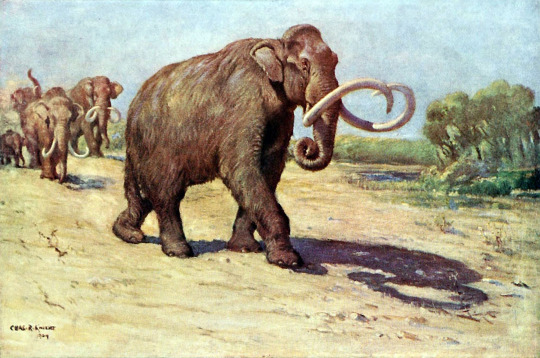
Columbian Mammoth by Charles R. Knight, in the Public Domain
The Cretan Dwarf Mammoth, M. creticus, is one of three diminished species of Mammoths, known from about 700,000 years ago on the island of Crete in the Mediterranean. These mammoths were very small, reaching only 1 meter tall and weighing only 310 kilograms - making it the smallest of the mammoths. It is possible that this animal wasn’t a mammoth at all, but another type of proboscidean; studies are still out on that one. Skulls of this animal may have formed the basis for the Grecian myth of the Cyclops!
The Sardinian Pygmy Mammoth, M. lamarmorai, was another species of small mammoth which evolved about 450,000 years ago, and is known only from the island of Sardinia. It grew about 1.4 meters tall and weighed up to 550 kilograms. It is known from many fossils, but no complete skeletons, mainly along the west coast. It is actually very uncertain what sort of mammoth this species originated from; it seems possible that the Steppe Mammoth colonized Sardinia, and then experienced Island Dwarfism as it was isolated on the island during an in-between period.
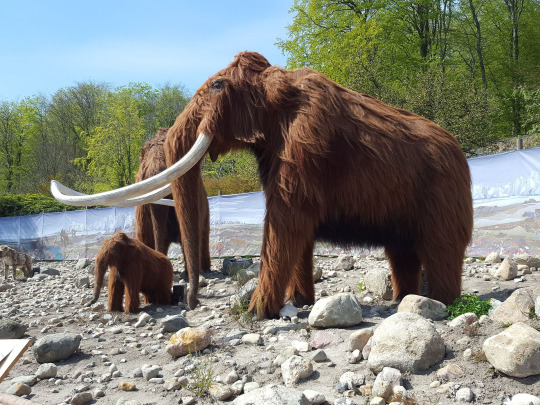
Woolly Mammoth by Honymand, CC BY-SA 4.0
The second to last species of Mammoth to evolve is, indeed, the best known of them all - M. primigenius, the Woolly Mammoth. Woolly Mammoths lived around the Arctic circle, in northern Eurasia and North America. Evolving from the Steppe Mammoth sometime between 400,000 and 150,000 years ago, it lived all the way up until the recent past, about 4,000 years ago - leading to the common fun fact that the Pyramids were built while Mammoths were still alive! Given it’s late position in the fossil record and extreme numbers during the last ice age, we have so many fossils and frozen remains of this animal that we know much of its life history (and the Woolly Mammoth remains one of the most controversial examples of something we might actually bring back through de-extinction). Because of this abundance of remains, we know a lot about its life appearance and life history - in fact, it’s the prehistoric animal with the best known appearance.
Woolly Mammoths were - as the name suggests - woolly, covered in layers of fur all over their bodies which was brown in color, as well as very thick layers of fat, very small ears and short tails, and flaps of skin covering orifices to keep them warm. The mammoths had oil glands in their skin, which secreted into their hair and helped the hair in repelling water, and gave the hair a glossy sheen. There was long, coarse guard hair on the outer layer, covering curly under-wool underneath. Interestingly enough, the Woolly Mammoth also had some weird physical characteristics not related to the warmth, such as a very high, domed head, and a sloping back with a shoulder hump. These were more present in adults, and not visible in juveniles. Their tusks were asymmetrical and extremely varied, and weirdly enough, most of the length of the tusks was inside the mouth. They had four molars at a time, used for chewing very tough vegetation.
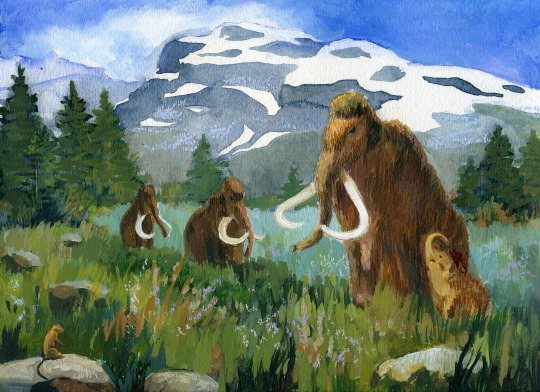
Woolly Mammoths by Kira Sokolvskaia, CC BY-SA 3.0
The Woolly Mammoth was the most specialized elephant to ever live, with extreme amounts of fat stored for warmth and when food was unavailable; their molars grew more quickly than in modern elephants; and their fur was so thick it was as though they wore mittens all over their bodies. They had differences in circadian rhythm clocks from living elephants in order to deal with extreme variation in daylight levels, and its proteins were less sensitive to heat. They had about 1.4 million differences in DNA compared to their closest living relatives, the Asian Elephants. They fed mainly on herbs, small flowering plants, shrubs, and mosses, and even fungus and poop from each other - not just the young, but the adults would do this too in times of food scarcity. They probably could reach up to 60 years of age, and they grew past adulthood - like living elephants.
The males also would go into musth - a period of extreme aggressiveness - during the breeding season, like living elephants today. They produced oil with glands that moved a smell associated with musth all over their fur, signaling to female mammoths they were ready to go, and to male mammoths to leave them alone. The breeding season was typically in the summer through the beginning of fall. The mammoths gave birth during the spring and summer, after a gestation period of nearly two years. While many reached older age and adulthood, bone disease was a very common cause of death for these mammals, as well as parasitic animals and infections after poorly healed injuries. Still, many were murdered by humans, and mammoth bits are used heavily in human society - for food, warmth, and art, with ivory from mammoths used in sculptures by early humans.
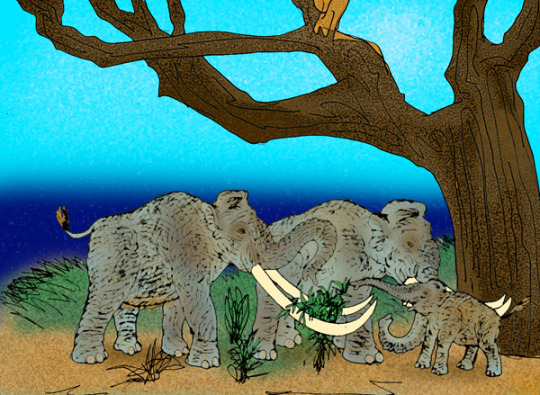
Pygmy Mammoth by Apokryltaros, CC BY 2.5
Finally, Pygmy Mammoths - M. exilis - were the last species to evolve, evolving approximately 60,000 years ago; still, it didn’t live as long as the Woolly Mammoth, dying out about 11,000 years ago, right at the beginning of the Holocene. The third case of insular dwarfism in the Mammoths, it grew to about 1.72 meters tall at the shoulders and 760 kilograms in weight. It evolved from the giant Columbian Mammoth, as well, making this all the more impressive. It is known from the Channel Islands along California, where Columbian Mammoths presumably reached via land bridges during some glacial period of the Ice Age. Possibly, they also swam there in search of food and escaping the large predators of the mainland such as Smilodon and the American Lion. It thrived across a variety of ecosystems, including plateaus, dunes, grasslands, forests, and even steppe-tundras.
~ By Meig Dickson
Sources under the Cut
https://en.wikipedia.org/wiki/Mammoth
https://en.wikipedia.org/wiki/African_mammoth
https://en.wikipedia.org/wiki/Columbian_mammoth
https://en.wikipedia.org/wiki/Mammuthus_creticus
https://en.wikipedia.org/wiki/Pygmy_mammoth
https://en.wikipedia.org/wiki/Mammuthus_lamarmorai
https://en.wikipedia.org/wiki/Mammuthus_meridionalis
https://en.wikipedia.org/wiki/Woolly_mammoth
https://en.wikipedia.org/wiki/Mammuthus_rumanus
https://en.wikipedia.org/wiki/Mammuthus_subplanifrons
https://en.wikipedia.org/wiki/Steppe_mammoth
#Mammuthus#Mammoth#Woolly Mammoth#Not a Dinosaur#Mammal#April Fool's#Prehistoric Life#Prehisotry#Paleontology#North America#Eurasia#Africa#Neogene#Quaternary#Herbivore#Ice Age#prehistory#biology#science#nature#factfile
862 notes
·
View notes
Video
instagram
Pueblos Nubios (parte 2 de 3) Yo hoy los llevo a conocer a los nubios que aún persisten en una de las laderas del Nilo, y en la isla de Elefantina, en Aswan. Se trata de los coloridos pueblos nubios de Siou y Koti, entre las ruinas de Abu y el Hotel Resort Mövenpick, donde podes pasear por sus callejuelas sombrías y jardines, es una maravillosa manera de experimentar la vida en la moderna “Elephantina”. Sus pueblos, son perfectamente identificables por las coloridas viviendas, los Nubios son una población tranquila que vive de las artesanías hechas a mano y hoy en día del turismo que llegue. Aunque ellos son músicos por naturaleza y tienen una sensación increíble para el ritmo (en especial con los tambores). Los “violines” típicos de los Nubios son los llamados “Rababa”, instrumento que, después de años y años, no han encontrado un sonido decente que no nos chirríe a los que no estamos acostumbrados. Las casas Nubias son muy coloridas, ... en éste caso, creo que se trata (por los dibujos) de un cibercafé ... pero además -como observación-, les cuento que por el clima, ellos cierran las persianas durante el día para evitar que el calor entre en la casa. Y por esto es que sus persianas están decoradas … en realidad no sé qué significan, pero se ven muy bien. #egipto #egipt #piramides #piramide #pirámides #desierto #arena #nubios #pueblos #pueblosmagicos #etnias #turismo #turistas https://www.instagram.com/p/CSrbj60ncfQ/?utm_medium=tumblr
#egipto#egipt#piramides#piramide#pirámides#desierto#arena#nubios#pueblos#pueblosmagicos#etnias#turismo#turistas
0 notes
Photo

The Meroe Head is a sculpture portraying the Emperor Augustus Ceasar who ruled in Rome from 27 BCE – 14 CE. It was discovered on the eastern bank of the River Nile between the Sudanese villages of Kegyek and Deraqab in December 1910. Its discovery was a complete surprise as the excavators who first saw it, recognised it as a classic Roman sculpture and wondered how it came to be in Sudan so far from the empire’s borders. Courtesy of the Greek historian, Strabo, we now have an answer to that question. In 25 CE a Meroite army, led by King Teriteqas and Queen Amanirenas raided Roman garrisons at Syene, Elephantina and Philae, in southern Egypt. Then after attacking landmarks, they decapitated Augustus’ statue and buried his head in the entrance to a temple. It served as a victory monument, allowing visitors to trample on the Emperor each time they entered the doors.
Since its discovery, the Meroe Head has captured people’s attention, which it no doubt did in ancient times as well. It has featured in numerous exhibitions including, but not limited to, the Mostra Augustea della Romanita, Italy 1937-38, The Meroe Head of Augustus: Africa defies Rome, UK 2014 and A History of the World in 100 Objects, worldwide 2015-2016. It has also become another example of the way in which Augustus used portraiture to his advantage. However, what is interesting is the comparisons made between Augustus and Mussolini and how they both used portraiture is a similar fashion.
Daily inspiration. Discover more photos at http://justforbooks.tumblr.com
7 notes
·
View notes
Photo

It is April, and I have finally gotten around to seriously tackling the Reading Women Challenge 2018. Here are four books to get me started.
“Die Idiotin” by Elif Batuman, translated by Eva Kemper from English, “The Idiot” for prompt 1) a book by a woman in translation.
“The Diviners” by Libba Bray” for prompt 23) the book that has been on your tbr the longest. In my case, plus the condition “and is available at the library”.
“The Lonely Hearts Hotel” by Heather O’Neill for prompt 19) a book from the Reading Women Award 2017 shortlist.
“Elephantinas Moskauer Jahre” by Julia Kissina (no English title), for prompt 7) a book set in Russia or by a Russian author: it was literally the only book by a female Russian author I could find in my library.
4 notes
·
View notes
Photo

Dendrobium uniflorum Griff. 1851 SECTION Distichophyllum Hkr.f Dendrobium elephantinum Finet 1903; Dendrobium revolutum Ridley 1907 non Lindl.; Dendrobium quadrisulcatum J.J. Sm. 1917; Dendrobium tonkinense De Wild. 1906; Dendrobium uniflorum var. angustum Quisumb. 1950; Distichorchis angusta (Quisumb.) M.A.Clem. 2003; Distichorchis elephantina (Finet) M.A.Clem. 2003; Distichorchis quadrisulcata (J.J.Sm.) M.A.Clem. 2003; Distichorchis uniflora (Griff.) M.A.Clem. 2003 #flowers #flower #plants #blossom #botanical #floral #bloom #orchidee #orcidea #orquideas #orquidea #orkide #orchideen #orchidstagram #orchidworld #orchids #orchidspecies #orchidea #orchid #rareorchids #greenhouse #bloomingnow #flowerstagram #flowersofinstagram #flowerphoto #orchidaddict #orchidcollection #orchidflower #instaorchid #orchidsofinstagram https://instagr.am/p/CJs3mUSMcEu/
0 notes
Text
Eraka (Typha elephantina) - Uses, Dose, Side Effects, Research
Eraka (Typha elephantina) – Uses, Dose, Side Effects, Research

Eraka (Typha elephantina) is an Ayurvedic medicine used to treat urine retention, dysuria, renal calculus, burning sensation, bleeding disorders, wounds etc. Gundra (Typha angustata) and Eraka (Typha elephantina) belongs to different species of same family.
Botanical Name – Typha elephantina
Family – Typhaceae
Indications of Eraka
Mutrakrichra – difficulty in passing urine (dysuria), urine…
View On WordPress
0 notes
Photo





OBJECT IN FOCUS: The Meroe Head of Augustus
IN an effort to share more of our favourite ancient objects from around the world, Ancient History Encyclopedia staff have taken a closer look at some really amazing objects or structures. Today’s Object in Focus is the Meroe Head of Augustus.
The Meroe Head is a sculpture portraying the Emperor Augustus Ceasar. It was discovered on the eastern bank of the River Nile between the Sudanese villages of Kegyek and Deraqab in December 1910. Its discovery was a complete surprise as the excavators who first saw it, recognised it as a classic Roman sculpture and wondered how it came to be in Sudan so far from the empire’s borders.
Courtesy of the Greek historian, Strabo, we now have an answer to that question. In 25 CE a Meroite army, led by King Teriteqas and Queen Amanirenas raided Roman garrisons at Syene, Elephantina and Philae, in southern Egypt. Then after attacking landmarks, they decapitated Augustus’ statue and buried his head in the entrance to a temple. It served as a victory monument, allowing visitors to trample on the Emperor each time they entered the doors.
Read More
207 notes
·
View notes
Photo

種が大きいと発芽も豪快や。burkiiかelephantinaか忘れてしまった。 #Elephantorrhiza_burkii_バーキー
0 notes
Photo

African bush elephant (Loxodonta africana)
Photo by Mark Bridger
#african bush elephant#african elephant#elephant#loxodonta africana#loxodonta#elephantinae#elephantidae#elephantoidea#elephantimorpha#elephantiformes#proboscidea#tethytheria#paenungulata#afrotheria#atlantogenata#eutheria#mammalia#tetrapoda#vertebrata#chordata#fave
19 notes
·
View notes
Photo

Dendrobium uniflorum Griff. 1851 SECTION Distichophyllum Dendrobium elephantinum Finet 1903; Dendrobium revolutum Ridley 1907 non Lindl.; Dendrobium quadrisulcatum J.J. Sm. 1917; Dendrobium tonkinense De Wild. 1906; Dendrobium uniflorum var. angustum Quisumb. 1950; Distichorchis angusta (Quisumb.) M.A.Clem. 2003; Distichorchis elephantina (Finet) M.A.Clem. 2003; Distichorchis quadrisulcata (J.J.Sm.) M.A.Clem. 2003; Distichorchis uniflora (Griff.) M.A.Clem. 2003 #flowers #flower #plants #blossom #botanical #floral #florals #bloom #blooms #botanical #orchidee #orchidarium #orchidhouse #orcidea #orquideas #orqidea #orquidea #orkide #orchideen #orchidstagram #orchidworld #orchids #orchidcollector #orchidlover #orcuidea #orchidshare #orchidspecies #orchidea #orchid #rareorchids https://instagr.am/p/CAKuCIhDmKW/
0 notes
Text
Rezension: “Elephantinas Moskauer Jahre” by Julia Kissina
Ich weiß ehrlich gesagt nicht, was ich da gerade gelesen habe. So ein bisschen magischer Realismus in Russland, so ein bisschen blühende Phantasie einer Dichterin / Schriftstellerin. Vielleicht auch eine große Traumlandschaft. Ein Bildungsroman, vielleicht, die Titel"heldin" geht schließlich zum Studium und für die große Karriere nach Moskau - doch eigentlich ein Bildungsroman ohne Entwicklung. Denn so richtig ändern sich ihre Situation und ihre Ansichten, ihre kindlich-naiven Träume, nicht. Es ist ein episodischer Roman, in dem jedes Kapitel nur vage mit dem davor und dem danach zusammehängt. Ein positiver Aspekt war die Sprache - Julia Kissina gelingt es, Russisch in ungeahnte kreative Höhen und metaphorische Spielerei zu erheben. (Oder die Übersetzerin ins Deutsche war einfach nur gut.) Es ist ein absurder Roman, wie beinah alles, was mit magischem Realismu zusammenhängt. Doch er kann durchaus auch Tiefe haben, wenn sich sich darauf einlässt.
0 notes